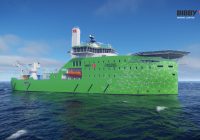‘Mad March’ on our waters
Perfect March weather coupled with a March long weekend and good fishing for tuna has led to busy coastal waters in March. The Marine Safety Officers have been flat out checking vessels on the water and at boat ramps across the state.
So far during March there have been more than 500 vessels checked by Marine Safety Officers. It is great to see the number of non-compliant vessels trending downwards in March with 35% of vessels non-compliant in March 2022 compared to 32% in March 2023.
During this period expired flares, not having 1-2 items of safety equipment on board and not wearing or carrying lifejackets were the three most common offences that expiations were issued for. Don’t risk a fine, check what you need to wear and carry for your vessel with the online safety equipment checker tool.
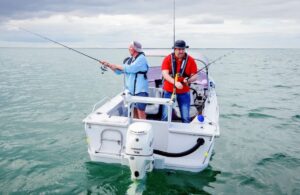
Report hazards and incidents on the water
The Department for Infrastructure and Transport (DIT), Marine Safety and Compliance team encourage members of the community to use the online reporting tool for reporting hazards and incidents on the water. This includes:
- If you observe a recreational vessel engaging in unsafe activities on South Australian waters including excessive speed, failure to wear a lifejacket, illegal activity, and incidents.
- Reporting hazards in waterways such as items floating in the water that could endanger other water users.
- Submitting accident reports if your vessel is involved in an accident. Please note the owner, master, or operator of any vessel must report any incident that results in loss of life, personal injury, or property damage to Marine Safety SA via the online reporting tool or a police officer within 48 hours of the incident.
You can link your online report to your SA.GOV.AU online account or enter as a guest. The reporting tool allows you to upload photos and video of an incident, hazard, or accident you would like to report. Please provide as much detail as possible in your report.
Once submitted, the DIT Marine a report comes through to the DIT Marine Safety SA team to follow up and action as required.
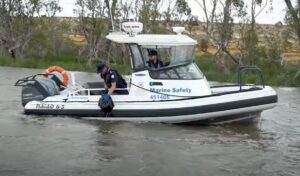
DIT Marine Safety Officers collecting hazards in the River Murray
Trip preparation – Checking your battery
Many recreational boat users are making the most of the warm weather this March and taking the opportunity to head out before daylight-saving ends. Did you know that flat batteries are a common cause of rescue callouts? Batteries can fail if they are not used for extended periods of time. Remember to always use marine batteries and keep your battery in the best possible condition.
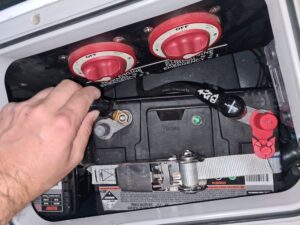
Before you go out on water, remember to check the following:
- The battery is charged regularly and only to the recommended level (never overcharge).
- Ensure the battery is the right strength to operate electrical equipment and start the engine.
- The battery is secured in brackets.
- The location is ventilated and vented before starting the engine.
- It has clean and secure terminals that are charged.
- The terminals should be greased regularly.
- The terminals and connections are tightly secured.
- Battery cells are topped up with distilled water.
- Turn off the power to the charger before disconnecting to reduce the risk of explosion.
Don’t be left stranded with a dead battery out on the water. For other tips on maintaining your vessel and making sure it is seaworthy visit the Marine Safety SA website.
Marine upgrades – O’Sullivan Beach boat ramp upgrade
The O’Sullivan Beach Boat Ramp will be upgraded to improve access and safety in response to the increasing demand and congestion at the ramp.
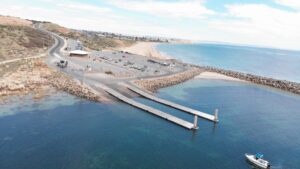
The upgrade will include:
- Construction of an additional boat ramp lane and pontoon, reducing wait times at the facility.
- Replacing and upgrading the current four-lane boat ramp launching facility, inclusive of the two existing pontoons and pontoon guide piles.
- Widening of the vehicle manoeuvring area to improve access and safety for launching boats.
- Undertaking protection works to extend the structural integrity and serviceable life of the facility.
- Improved disability access to a ramp and pontoons.
Upgrade works are expected to start from next month and are due to be completed by late 2023, with the intent to avoid impacts on peak summer recreational boating activities in the December and January holidays.
To enable works to be completed safely and as quickly as possible, the O’Sullivan Beach Boat Ramp and main carpark will be temporarily closed for recreational use from late April 2023 until project completion.
During this closure, boats can continue to launch from other similar facilities including Wirrina, West Beach, Outer Harbor, North Haven, Garden Island, and St Kilda.
For further information on the upgrade visit the O’Sullivan Beach boat ramp upgrade project page. You can register via this page for project updates.
Safe operation – Don’t carry damaged and expired safety equipment!
Marine Safety Officers undertaking routine vessel safety and compliance checks on the water recently found flares on board a boat that had expired in 1987! Other items found included damaged flares and a fire extinguisher that was expired and visibly damaged.
Using expired or damaged flares and fire extinguishers in an emergency will put your life and all others on board, at risk. Flares are a key form of communication to alert others if your vessel is in distress and a fire on board a vessel can be deadly if you don’t have a working fire extinguisher.
Remember, failing to carry compliant safety equipment is an offence. The operator of the boat carrying this expired and damaged equipment was issued with a fine.
Use the Marine Safety SA safety equipment online tool and answers some quick questions to see which boating safety equipment you need. It will depend on the type of vessel, size of vessel, which waters you are operating in and when you are operating. It’s important to keep everyone safe on board.
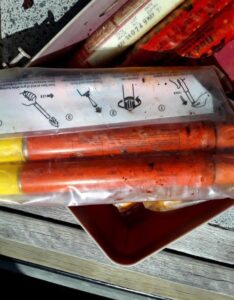

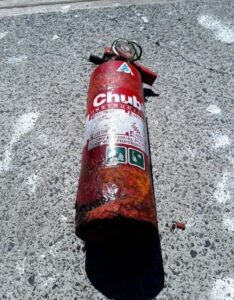
Boating rules refresher – did you know? Give way rule
You learnt your give way rules to pass your boat licence test, but do you remember them?
Each month Marine Safety SA are going to provide some tips on boating rules as a refresher for everyone. This month they are looking at the give way rules.
If you are required to give way to another vessel, take early and positive action so that your intentions are clear. Avoid making a series of small changes in speed or course that may not be apparent to the other vessel.
If another vessel is required to give way to you, maintain your present speed and course unless it is obvious that a collision may occur. In this case stop, slow down or turn away.

Giving way in rivers and channels
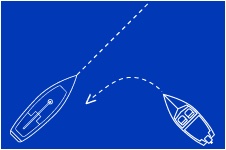
Giving way sailing and power-driven vessels
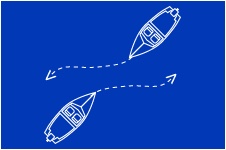
Giving way power driven vessels meeting head-on
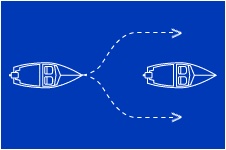
Giving way vessels overtaking
The diagrams above show the different give way rules on the water.
Find more information about giving way and other boating rules, visit Marine Safety SA boating rules.
Video of the month – Choose a safe location for water skiing
The River Murray is slowly getting busy again after flood waters have receded and restrictions on operating have been removed. An influx of holiday makers are expected during the upcoming Easter and April school holidays. The video above reminds everyone to choose a safe location for water skiing away from the crowds where possible, while always thinking about other users and people on the banks of the river.
The operator of a vessel should be keeping a lookout for any hazards ahead and the observer should be keeping an eye on the water skier/s being towed and any hazards they may encounter. It is safest to do a run without skiers to check the route for hazards before skiing. For rules about towing skiers safely, visit Marine Safety SA towing and boating.
Safety tips for vessels – Jet ski safety
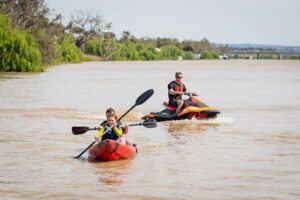
Make sure you stick to 4 knots when operating within 50 metres of people in the water
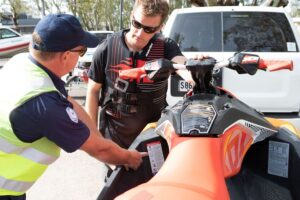
Ride smart stickers must be displayed on your jet ski
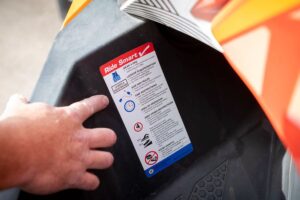
Ride smart sticker
Stay safe on your personal watercraft (commonly known as a jet ski) by following these rules and safety tips:
Rules:
The same rules for motorboats apply to a personal watercraft with the following additions:
- The operator and passengers must wear a level 50 or 50S lifejacket at all times on a jet ski. You cannot wear other level lifejackets.
- They can only be operated by people over 16 years old who hold a boat operator’s licence. Special permit holders must not operate jet skis.
- Unless zoned otherwise, a 4-knot speed limit applies to all personal watercraft within 200 metres of the metropolitan shoreline (between Outer Harbor southern breakwater and the southern end of Sellicks Beach) and the backwaters of the River Murray.
- There are several areas within South Australia where waters with similar 4 knot restrictions or exclusions are marked with signs. Henley Beach is one of these restricted areas for jet skis within 200 metres of the shoreline. If in doubt, check with the local council.
- For rules on displaying a Ride Smart sticker and registration labels, visit Marine Safety SA – Personal watercraft safety.
Tips for operating safely:
- Always attach the ignition cut-out safety line to your lifejacket.
- Consider suitable footwear, goggles and gloves.
- Check the weather conditions before you go out.
Towing water skiers:
- Jet skis are increasingly being used for water skiing. The same rules apply to jet ski operators as all powerboat operators, including the requirement to carry an observer who must always face the skier.
- You must have seating for at least two people but ideally three, in case the skier is injured. It is also advisable to use a personal watercraft that is designed for towing. For more information about towing safely, visit Marine Safety SA towing and boating.






